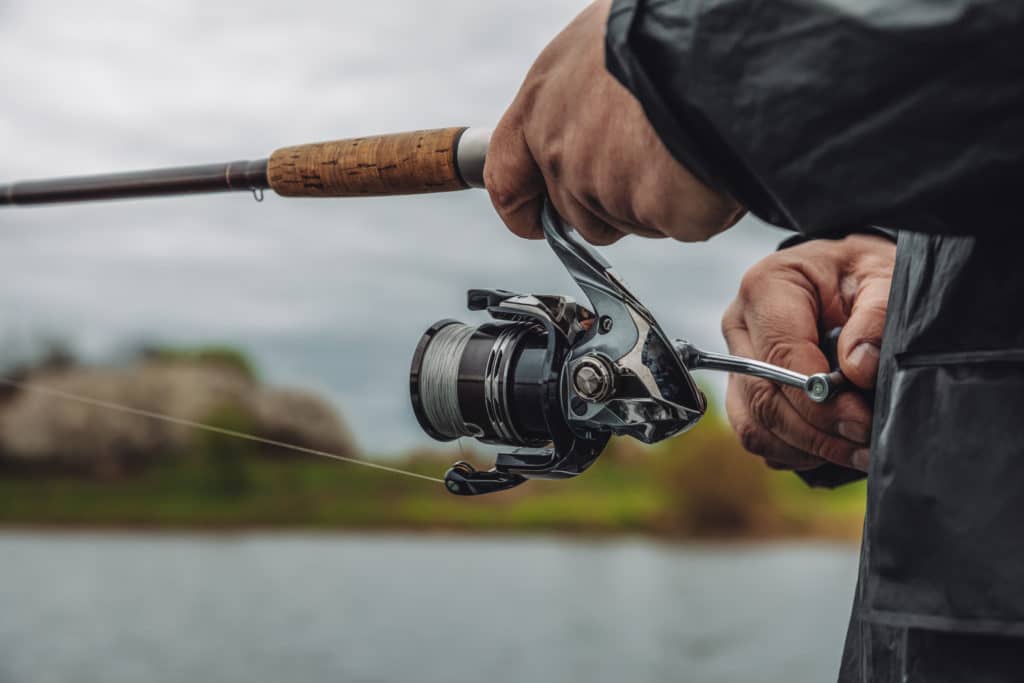There are tons of tips and tricks that you can follow to make the most out of your fishing experience.
Possibly one of the most important, and also one of the easiest, things you can do to improve your fishing ability is to adjust and set the drag on your reel.
One simple change can mean the difference between a catch and the one that got away.
Below, we are going to take a look at how to set the drag on a reel to help you have the most success possible on your fishing adventures.
Let’s get to it!

Contents
What is a Drag?
The drag on a reel refers to the friction plates that hold the line in place when pressure or weight is added to your hook.
You can adjust the drag on your reel quickly and easily, ensuring that your catch stays on the hook without unnecessary damage to your line, rod, or reel.
When your reel faces any resistance from a fish pulling on your line hard enough, the friction plates cause the reel to rotate in the other direction.
This, in turn, releases some line to give you the chance to reel it in safely.
The drag on your reel can be set according to the type of fish you hope to catch and the waters you are fishing in and is also dependent on the type of rod, reel, and line you are using.

How to Adjust and Set the Drag on your Reel
Before we show you the easy steps you need to take to adjust your drag, there are also a few other important things you should know about the drag and how important it is to ensure that your drag is set correctly.
According to reel and line manufacturers’ specifications, the pounds of drag on your reel should not be more than 25% of the line’s maximum resistance or breaking strength.
You can check for this number on your line packaging.
Take the maximum breaking strength and divide it by four to get the drag amount.
This is a rule of thumb that fishing line manufacturers use when determining how much additional pressure their fishing line can withstand.
Now that we have looked at the numbers behind setting your drag, let’s dive into how to set the drag.
You can easily test the breakage strength of your line and the resistance of your reel by attaching a scale to the end of your fully assembled rod.
Here is an easy-to-follow step-by-step guide on checking and adjusting the drag on your real.
Step #1: Assemble Your Rod
Set your rod, reel, and line up as if you were about to go fishing.
Add on your hook, sinkers, and any bobbers you may be using.
These should be placed a few inches above the end of your line, leaving space for a spring scale to be attached to measure the amount of pressure your reel can withstand before the pair of friction plates or drag give in and the line extends.
Step #2: Attached a Scale to The End of Your Line
A luggage scale is ideal, but you can also purchase a scale from any fishing tackle shop.
Tie the scale to the end of your line with the hook and any bobbles or sinkers above the scale.
Ensure that it is tied tightly so as not to come loose while testing your line’s breakage strength.
Step #3: Position Your Rod at A 45-Degree Angle
This is to mimic your rod’s position if you were fishing.
It might be helpful to get someone to help you with pulling on the scale and taking the reading, allowing you to focus on holding the rod in place and paying close attention to the reel and friction plates of the drag.
Rod angle is important and the digital scale should be kept vertical at all times.
Step #4:Pull Down on The Scale
Pay close attention to the line and reel.
If your drag slips, stop immediately, hold the scale in place, and take a reading.
You will know your drag has slipped when the line extends from your reel.
Step #5: Adjust Your Drag
Using the simple equation we explained above, which is Breakage Strength divided by four, you can calculate what your drag should be set to.
Note again that the drag depends on your line and the reel you are using, and these factors should both be considered when making any adjustments.
The drag has a knob adjustment on most reels to make setting the drag easier.
Turn the drag knob until you reach the desired setting.
As you can tell, this is a simple method of adjusting the drag on your reel that can make a huge difference in your fishing game.
Whether you are saltwater fishing or hoping to hook some trout in a stream, your reel’s drag is important.
Reel setup should be the first step in any fishing experience and knowing where your drag adjustment knob is should be one of the first things you look for when you buy a fishing reel.
Correct drag settings increase the likelihood of reeling in a monster fish with no damage to your rod, reel, or line.
Choosing the Best Line
While drag is important, so too is the type of line you use. The choice of the line depends on the following factors:
- Type of reel
- The type of fish species you are hoping to catch and reel in
- Type of waters you are fishing in (deep water vs. shallow water)
Hands down, one of the strongest and most durable fishing lines you could possibly buy for your fishing rod is a braided line.
While it is thicker than most fishing lines, it is also the strongest and can be used on all conventional reels and fishing types.
Braided fishing line has the highest break strength and requires the drag setting of your reel to be fairly low.
Investing in some good-quality braided lines can help you increase the chances of catching and reeling in a hooked fish successfully.
Conclusion
Drag adjustments and setting the drag slippage of your fishing reel is both important and necessary to ensure that you successfully reel in whatever you have on your hook.
Ensuring that the drag is set according to the type of fish you would like to catch and the waters you will be fishing in is important.
By following the easy-to-follow steps we have laid out above, you can identify the best drag setting for your reel and the type of line you will be using based on the actual breaking strength of that line.







